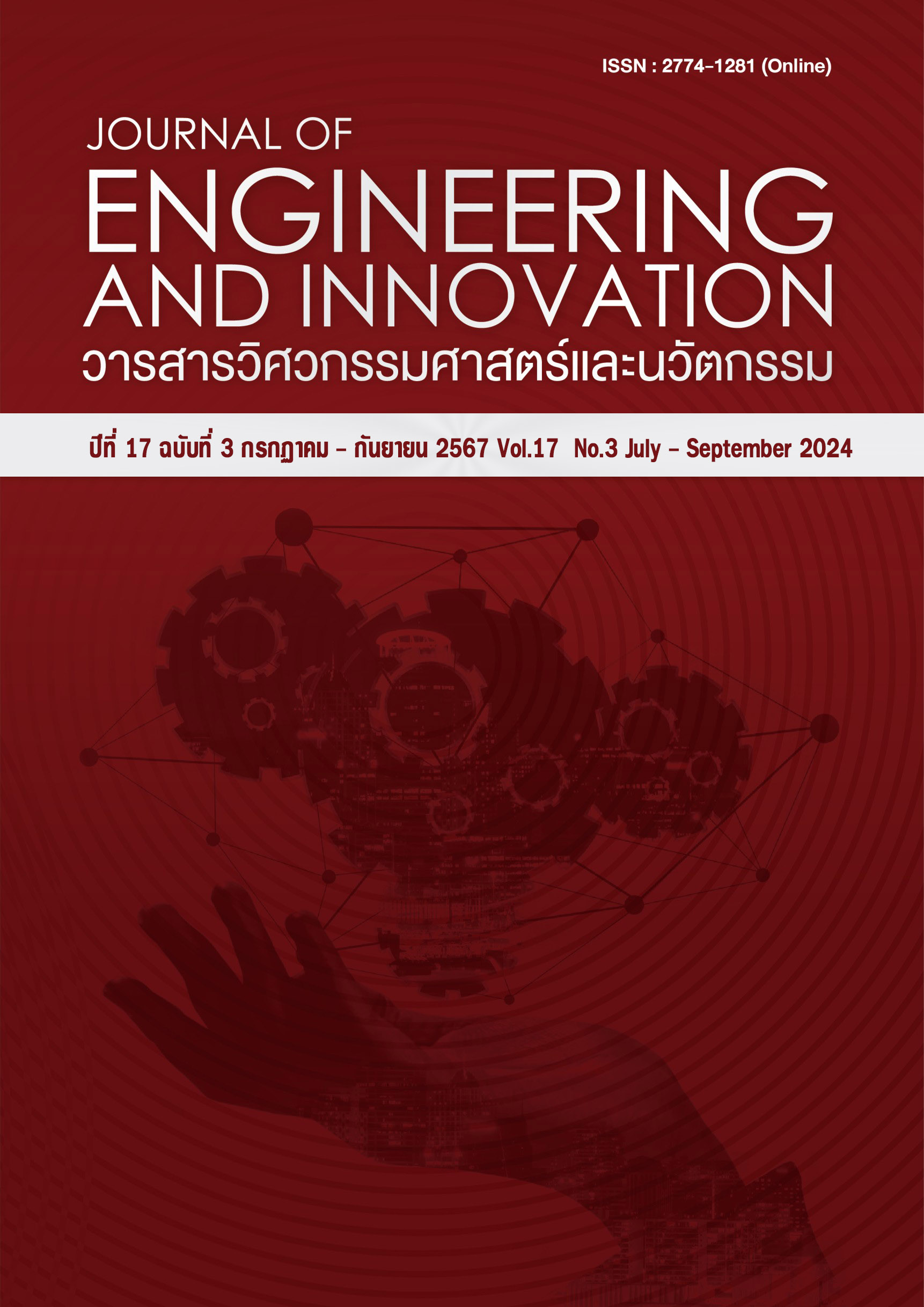Prediction of moisture content, modulus of elasticity and specific gravity of mixed grade Para rubber timber using near-infrared hyperspectral imaging technique
Main Article Content
Abstract
This research aims to study the prediction of percent moisture content (MC), modulus of elasticity (MOE) and specific gravity (SG) of dried mixed grade para rubber timber and demonstrate the prediction diagram by using near infrared hyperspectral imaging technique (NIR-HSI) in 900-1,700 nm range of reflectance mode. The absorbance data of para rubber timber were utilized to predict moisture percentage, modulus of elasticity and specific gravity by partial least squares regression (PLSR) method. The results revealed that the absorbance data which were pretreated using mathematical method obtained the highest correlation coefficients (Rp) of the MC, MOE, and SG prediction equation of 0.95, 0.74 and 0.51, respectively. The root mean square error of prediction (RMSEP) was 0.72 %db, 1.49 GPa and 0.03, respectively. In addition, the near-infrared hyperspectral imaging technique effectively illustrated the distribution of MC, MOE, and SG values of para rubber timber across the entire surface area in a non-destructive and quickly. However, it should focus on developing more accurate prediction equations by expanding the sample size and covering a broader range for future sample predictions.
Article Details
References
สำนักงานเศรษฐกิจการเกษตร. ข้อมูลเศรษฐกิจการเกษตร. เข้าถึงได้จาก: https://www.oae.go.th. [เข้าถึงเมื่อ 16 พฤษภาคม 2565].
ศูนย์ข้อมูลยางและไม้ยาง สำนักงานเศรษฐกิจอุตสาหกรรม. สถิติส่งออกยางพาราไทย. เข้าถึงได้จาก: http://rubber.oie.go.th. [เข้าถึงเมื่อ 16 พฤษภาคม 2565].
วรวรรธน์ นกน้อย. การทำนายปริมาณความชื้น ความถ่วงจำเพาะ และความเเข็งเเรงไม้ยางพาราด้วยเทคนิคสเปกโทรสโกปีอินฟราเรดย่านใกล้ [วิทยานิพนธ์].วิศวกรรมศาสตรมหาบัณฑิต (วิศวกรรมเกษตร).กรุงเทพมหานคร: บัณฑิตวิทยาลัย, มหาวิทยาลัยเกษตรศาสตร์; 2561.
สำนักงานมาตรฐานผลิตภัณฑ์อุตสาหกรรม กระทรวงอุตสาหกรรม. ไม้ยางพาราแปรรูป. มอก. 2423–2552.
Tsuchikawa S. A Review of Recent Near Infrared Research for Wood and Paper. January Applied Spectroscopy Reviews. 2007; 42(1): 43–71.
สุธิดา เรืองขษาปณ์. การพัฒนาและทดสอบสมการทำนายความชื้นไม้ยางพาราแปรรูปด้วยเนียร์อินฟราเรดสเปกโทรมิเตอร์แบบพกพา [วิทยานิพนธ์].วิศวกรรมศาสตรมหาบัณฑิต(วิศวกรรมเกษตร). กรุงเทพมหานคร: บัณฑิตวิทยาลัย, มหาวิทยาลัยเกษตรศาสตร์; 2563.
Ma T, Morita G, Inagaki T, Tsuchikawa S. Moisture transport dynamics in wood during drying studied by long-wave near-infrared hyperspectral imaging. Cellulose. 2022; 29: 133–145.
Haddadi A, Leblon B, Burger J, Pirouz Z, Groves K, Nader J. Using near-infrared hyperspectral images on subalpine fir board. Part 2: Density and basic specific gravity estimation. Wood Material Science & Engineering. 2015; 10(1): 41–56.
Sofianto I.A, Inagaki T, Ma T, Tsuchikawa S. Effect of knots and holes on the modulus of elasticity prediction and mapping of sugi (Cryptomeria japonica) veneer using near-infrared hyperspectral imaging (NIR-HSI). Holzforschung. 2019; 73(3): 259–268.
Thumm A, Riddell M, Nanayakkara B, Harringtona J, Meder R. Near infrared hyperspectral imaging applied to mapping chemical composition in wood samples. Journal of Near Infrared Spectroscopy. 2010; 18: 507–515.
Wu D, Sun D.W. Advanced applications of hyperspectral imaging technology for food quality and safety analysis and assessment: A review–Part I: Fundamentals. Innovative Food Science and Emerging Technologies. 2013; 19: 1–14.
American Society for Testing and Materials (ASTM). Standard Test Methods for Small Clear Specimens of Timber, D 143-94; 2000.
Technical Association of the Pulp and Paper Industry (TAPPI). Test methods Standard Practice; 2006.
Meier K.J, Brudney J.L, Bohte J. Applied Statistics for Public and Nonprofit Administration (8th ed.). Boston USA: Wadsworth; 2014.
Williams P. Grains and seeds. In: Ozaki Y, McClure W.F, Christy A.A. (Eds.). Near-Infrared Technology in food science and technology. New Jersey: John Wiley & Sons, Inc; 2007. p. 165-217.
Chanpet M, Rakmak N, Matan N, Siripatana C. Effect of air velocity, temperature and relative humidity on drying kinetics of rubberwood. Heliyon. 2020; 6(10): 1-15.
Gerhards C.C. Effect of moisture content and temperature on the mechanical properties of wood: an analysis of immedia effects. Wood and Fiber. 1982; 14(1): 4–36.
Hossain M, Mondal S, Banerjee A, Lekshmi N.M, Manojkuma B. Changes in the Specific Gravity in Rubber Wood Treated with Cashewnut Shell Liquid and Nano Based Wood Preservatives. Journal of Current Microbiology and Applied Sciences. 2018; 7(10): 720-723.
Workman J, Weyer Jr.L. Practical guide and spectral atlas for interpretive near-infrared spectroscopy (2nded.). United States of America; 2012.
Iwamoto M, Kawano S, Abe H. Analysis of hydrogen bonding related to water in foods. NIR News. 1995; 6(3): 10-12.
Fujimoto T, Kurata Y, Matsumoto K, Tsuchikawa S. Feasibility of near- infrared spectroscopy for online multiple trait assessment of sawn lumber. Journal of Wood Science. 2010; 56: 452-459.
Williams P, Norris K. Near-Infrared Technology in the Agricultural and Food Industries. American Association of Cereal Chemists. USA; 2001.
Osborne B.G, Fearn T, Hindle P.H. Practical NIR spectroscopy with application in food and beverage analysis. Longman Scientific and Technical: Harlow; 1993.
Ozaki Y, Siesler H.W, Kawata S, Heise H.M. Near-Infrared Spectroscopy. Principles, Instruments, Applications. WILEY-VCH: Germany; 2002.
ฐิตาภรณ์ ภูมิไชย์, กฤษดา สังข์สิงห์, จิรวัฒน์ ริยาพันธ์, เฉลิมพล ภูมิไชย์. คุณสมบัติทางเคมีและเชิงกลของไม้ยางพารา. วารสารวิชาการเกษตร. 2558; 33(2): 144–158.
Awais M, Altgen M, Makela M, Belt T, Rautkari L. Quantitative prediction of moisture content distribution in acetylated wood using near-infrared hyperspectral imaging. Journal of Materials Science. 2022; 5(7): 3416–3429.

